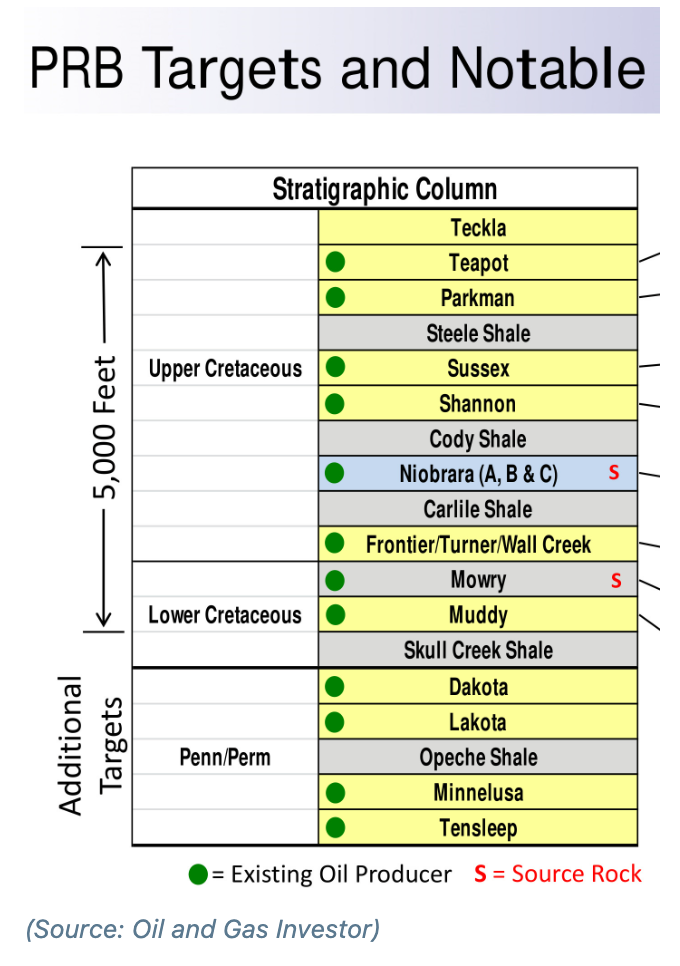More long money is entering the multi-million-acre Powder River Basin, proving early entrants’ potential from the stacked pay.
A nearly $1 billion midstream deal in early September is long on new production potential of Wyoming’s Powder River Basin.
Western Midstream Partners LP is buying 1,500 miles of gas-gathering pipe, 380 MMcf/d of processing capacity and the 120-mile, 38,000 bbl/d Thunder Creek NGL pipeline from Riverstone-backed Meritage Midstream Services II LLC for $885 million, cash.
The infrastructure is in the Converse, Campbell and Johnson counties area of the basin’s leading producers: Devon Energy Corp., Continental Resources Inc., Occidental Petroleum Corp., Anschutz Exploration and EOG Resources Inc.
Western’s looking for the 1.4-million-dedicated-acre bolt-on to draw other operators into the system. Enverus reported after the news, “While Meritage’s counterparties were not named, they probably include Devon Energy, which had built much of the system to support its [Powder] operations.”
The basin’s rig count was 15 in late August, similar to its year-end 2019 exit rate and its post-Covid recovery last year.
Clay Gaspar, Devon’s COO, told securities analysts in August that appraisal continues in its 300,000 net acres. Three-mile-lateral tests have been working. Also, “since we are not observing any degradation in the results from three-well spacing, we plan to test four wells per section [in this half],” he said.
Devon’s northern Powder holding “could extend the Niobrara potential into Campbell County.” Overall, findings have been “evident that our [acreage position] is providing Devon important resource catalysts for the future,” Gaspar said.
In its Converse County leasehold, Devon has been drilling the Teapot formation in addition to Turner, Parkman and Niobrara. Its 2022 Powder production averaged 19,000 boe/d, about 84% oil and NGL.
The Occidental Petroleum holding in the Powder came with its acquisition of Anadarko Petroleum Corp. Vicki Hollub, Oxy president and CEO, told analysts in August that Permian Basin learnings are being transferred to the Powder. In the southern fairway, “we're seeing good results there. And our appraisal team is beginning to work in the northern part,” she said.
Anschutz, which was early in new, unconventional Powder exploration, has five rigs drilling in its nearly 500,000 net contiguous acres, producing more than 25,000 boe/d.
Joe DeDominic, CEO, said at Hart Energy’s SUPER DUG conference in May it’s moving to full development mode now. “We see a decade-plus of drilling depending on [our rig] activity level. ...So we have a lot of inventory. We're very pleased with that.”
Anschutz plans to expand to 2.5-mile laterals in one of its blocks in Campbell County “and then we can expand that as we move north,” he told Hart Energy.
New entrants would need to be well-banked, he added. “You [have to] spend enough money to actually grow or you’re kind of not doing much at all. You're maybe staying flat at best.”
Property is changing hands. Investment firm Pan Management’s OneRock Energy Holdings LLC bought Apollo Global Management-backed Northwoods Management Co.’s 160,000 mostly contiguous net acres in Converse, Campbell and Johnson counties this summer that’s producing some 5,000 boe/d.
Northwoods had picked up 112,000 of its acres, which were producing some 2,000 boe/d at the time, in January 2018 from SM Energy Co. for $500 million.
Meanwhile, newly private Continental has been adding to its Powder. Harold Hamm, chairman, told Hart Energy this summer the Powder’s “needed somebody that had enough size and scale to consolidate the basin. And we’ve done a pretty good job of that, putting a huge leasehold together—and big enough that we could add scale to it.”
There is a bounty of formations for tapping. “It’s a stacked pay. I mean, it’s just pay after pay after pay.”





